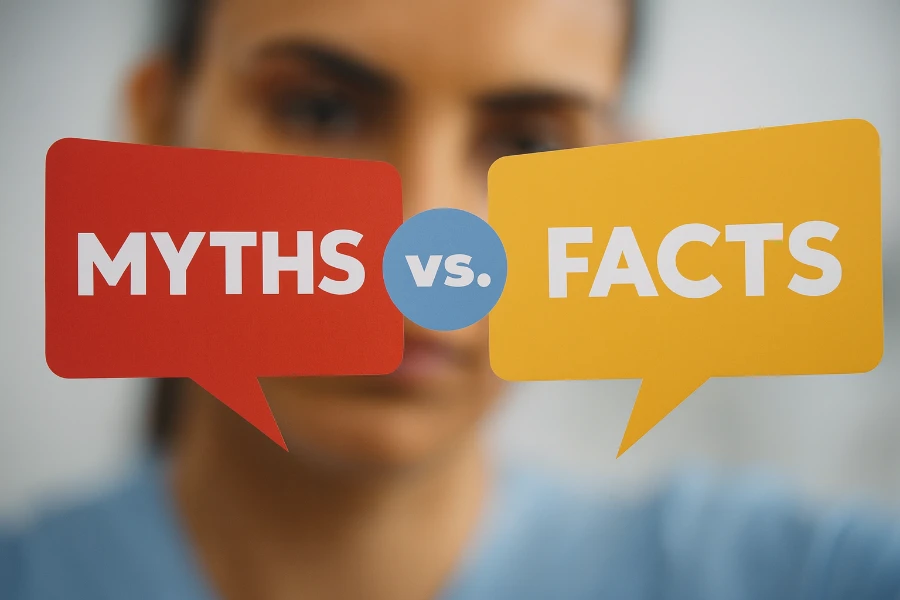Key Takeaways
- Relying on smell to diagnose diabetic emergencies is inaccurate—objective testing must always guide EMS response.
- Myths like “fruity breath = diabetes” or “drunk means alcohol” lead to misdiagnosis and delayed care.
- Evidence-based training and critical thinking are essential to replacing outdated field habits and improving patient outcomes.
Why EMS Myths Persist in the Field
Origins of Misinformation
False assumptions spread quickly in high-pressure environments like emergency medical services. New recruits often hear simplified tips from seasoned medics during ride-alongs or casual briefings. These ideas get repeated, rarely questioned, and eventually become field folklore. Myths rooted in half-truths gain credibility when they appear to match real patient encounters. Once these ideas enter the culture, they are difficult to dismantle without structured correction.
The Real-World Risks of Clinging to Myths
Relying on false assumptions puts patients and providers at serious risk. Misinterpreting symptoms can lead to inappropriate treatment or critical delays in care. Some myths cause EMS teams to ignore red flags or overlook important tests. These errors can damage the reputation of first responders and erode public trust. Legal consequences may follow if a patient suffers due to outdated or false field logic. Rigorous programs like ACLS certification reinforce evidence-based decision-making and help eliminate outdated emergency care assumptions.
The “Fruity Breath” Misconception and Its Limits
What Fruity Breath Actually Signals
Fruity-smelling breath occurs in specific medical situations, not all diabetic emergencies. Diabetic ketoacidosis (DKA) triggers the production of ketones, which release acetone—a compound with a sweet or fruity odor. This scent may become noticeable when blood sugar runs extremely high, usually in patients with type 1 diabetes. The presence of this odor reflects a biochemical process, not a general diabetic condition. Smelling acetone should alert providers to one narrow scenario, not serve as a diagnostic shortcut according to the CDC.
Why This Cue Should Never Be a Primary Assessment Tool
Olfactory cues are subjective and unreliable across field conditions. External odors, masks, and environmental contamination can obscure or mimic acetone’s scent. Not every patient with DKA emits a noticeable fruity odor, and many other symptoms overlap with intoxication or infection. Using smell alone increases the chance of anchoring bias, where responders stop evaluating other causes. MedlinePlus stresses that ketone testing offers more reliability than smell in identifying DKA.
Smell Isn’t a Diagnosis: Common Scenarios That Confuse New Medics
Alcohol vs. DKA: A Dangerous Misread
Many DKA patients appear confused, agitated, or unsteady—just like intoxicated individuals. Some even have breath that smells like alcohol due to overlapping chemical compounds. Rushing to judgment can lead medics to assume intoxication and skip vital glucose testing. Proper assessment includes checking blood sugar, evaluating pupil responses, and searching for medical alert IDs. Every altered-mental-status call deserves full workup before assigning a cause.
Body Odor and Stinky Feet Myths
Urban legends often link diabetes with foot odor, but no science supports this belief. While poorly managed diabetes can lead to foot ulcers or infections, these conditions don’t create a signature scent. Poor hygiene can occur in any population and should not be used to profile or assume disease. Foot evaluations should focus on wounds, temperature, sensation, and circulation. Confusing hygiene with pathology is both harmful and unprofessional.
Hyperglycemia and the Myth of “Sweetness”
High blood sugar does not smell sweet or give patients a sugary aura. Hyperosmolar hyperglycemic state (HHS), for example, presents with extreme dehydration and confusion but no odor. UCSF research shows that many elderly patients develop HHS without prior diabetes history, and mortality rates remain high. Medics relying on smell might miss this condition entirely. HHS often affects elderly patients with type 2 diabetes and progresses gradually. Blood glucose testing remains the only reliable way to identify these high-sugar states.
The Myth of Uniform Diabetic Emergencies
Not all diabetic emergencies present alike. This quick-reference chart highlights the clinical differences EMS teams must recognize to guide proper interventions.
| Feature | DKA (Diabetic Ketoacidosis) | HHS (Hyperosmolar Hyperglycemic State) | Hypoglycemia |
|---|---|---|---|
| Typical Blood Sugar | Usually >250 mg/dL | Usually >600 mg/dL | Often <70 mg/dL |
| Main Population | More common in type 1 diabetics | Typically affects elderly with type 2 | Any diabetic or non-diabetic patient |
| Key Symptoms | Fruity breath, deep breathing, vomiting | Extreme dehydration, confusion, visual issues | Sweating, tremors, altered behavior, seizures |
| Onset | Rapid (hours to 1–2 days) | Gradual (days to a week) | Sudden (minutes to hours) |
| Ketones Present? | Yes—often moderate to large | No or only trace amounts | No |
| Primary Prehospital Action | IV fluids, monitor airway, transport | IV fluids, vitals, rapid transport | Administer glucose or dextrose, recheck vitals |
Not All Crashes Are Hypoglycemia
Hypoglycemia can cause seizures, aggression, and unconsciousness—but it is not the only possible cause. A patient found unresponsive may also suffer from head trauma, stroke, or narcotic overdose. Low blood sugar remains common but should never be assumed without checking glucose. Medics should use verbal stimuli, perform fingersticks, and consult bystanders. Anchoring to hypoglycemia alone may overlook serious parallel conditions.
Hyperglycemia Doesn’t Always Mean DKA
Not every high reading signals ketoacidosis. DKA typically presents with abdominal pain, deep breathing, and dehydration. Hyperosmolar states, though, develop differently and can escalate silently over days. Mislabeling all high readings as DKA wastes time and delays appropriate care. A thorough exam can reveal the right path—especially when lab data is sparse or unavailable. Individualized responses prevent dangerous overgeneralization.
Diabetic Patients Can Still Have Other Problems
Patients with diabetes also suffer heart attacks, infections, strokes, and trauma. Focusing only on glucose distracts from these critical possibilities. Chest pain or altered mental status deserves a broad differential diagnosis. Crew members should resist tunnel vision and keep multiple possibilities in mind. Glucose readings help guide treatment but never replace a full patient evaluation.
The Role of Objective Assessment in Emergency Care
Tools That Replace Guesswork
Modern EMS tools allow precise, rapid patient evaluation in the field. Capillary blood glucose meters give instant feedback on sugar levels, just as BLS for healthcare providers training emphasizes rapid, informed intervention during emergencies. Ketone testing and CGMs (continuous glucose monitors) can offer real-time clues about diabetic control. Pulse oximetry, temperature checks, and mental-status scoring add further insight. These tools turn guesswork into evidence, guiding correct decisions.
Combining Scene Clues with Medical Data
Scene observations can enhance clinical findings when used wisely. Medication bottles, insulin pens, and CGM devices provide helpful background. Interviewing family members or caretakers often fills in missing history. When a patient is unresponsive, medics should scan for wristbands, wallet cards, or tattoos. Gathering full context supports better judgments and reduces the risk of missteps.
3 Practical Tips to Dispel Field Myths
Don’t Trust Your Nose—Trust Your Tools
Smell is not a diagnostic method and should never substitute objective testing. Medics must reach for their glucometers, not guess by scent. Fingersticks, vitals, and patient history yield far more reliable results. Dismantling this habit starts with practice and repetition during drills. Instructors should model this behavior early in training.
Treat the Patient, Not the Story
Every patient deserves a fresh assessment, regardless of what bystanders suggest. Family reports and neighborhood gossip often skew perception. While these details help build context, they cannot replace clinical evaluation. Recruits should learn to collect evidence before concluding anything. This practice guards against bias and keeps care consistent.
Encourage Myth-Busting in Crew Culture
Shifting culture begins with honest dialogue between experienced providers and newcomers. Debrief sessions should explore not just outcomes, but thought processes. Instructors and leaders must correct outdated beliefs during downtime or drills. Sharing accurate data and real-world examples strengthens the team’s collective wisdom. Normalizing myth-busting helps protect both medics and patients.
Training Culture: How to Stop the Spread of Bad Advice
Teaching Critical Thinking in EMS Education
Education must move beyond memorizing signs and symptoms. Students need to learn why things happen—not just what to look for. Encouraging questions and presenting contradictory case studies fosters analytical thinking. Simulation-based learning in paramedic training helps trainees recognize that similar symptoms don’t always mean the same cause. Training focused on mechanisms builds better judgment.
The Instructor’s Role in Correcting False Narratives
Instructors carry responsibility for shaping how new providers think and speak. Teaching with clear, consistent language limits confusion and reduces spread of myths. Correcting students gently but firmly helps reframe bad habits early. Leaders should keep current with evidence-based practices and update lessons accordingly. Mentorship built on accuracy benefits the entire system.
Addressing the Myth with the Public
What Patients Think They Know
Many laypeople believe diabetes “has a smell” or that “it’s just about sugar.” These misconceptions often come from media portrayals or secondhand stories. Medics must correct these beliefs carefully during emergency encounters. Framing explanations with compassion maintains trust while delivering facts. Educating families improves compliance and reduces future calls.
Educating Bystanders Without Creating Panic
During chaotic scenes, family members often insist on a specific cause. Medics can validate their concern while guiding them toward evidence-based understanding. Avoiding confrontation and using simple language creates a calmer atmosphere. Sharing how medics test for various conditions helps families see the full picture. Respectful correction earns cooperation and protects the patient’s dignity.
Frequently Asked Questions (FAQ)
What’s the difference between DKA and hypoglycemia in symptoms?
DKA involves high blood sugar, deep breathing, and fruity breath, while hypoglycemia causes sweating, confusion, or seizures. Both require prompt but different treatments.
Is there *any* scenario where breath smell helps EMS?
Fruity breath may support a DKA diagnosis, but never rely on it alone. Always confirm with glucose and ketone readings.
Why do some diabetic patients seem drunk?
Low blood sugar or DKA can mimic intoxication with slurred speech and confusion. Objective testing is essential to avoid mistakes.
Can EMS diagnose diabetes in the field?
EMS cannot officially diagnose diabetes but can identify emergencies and recommend follow-up. Blood sugar readings guide immediate care only.
A Better Foundation for Field Assessments
Prioritize Evidence-Based Practice
Modern EMS must prioritize proven techniques over inherited habits. Relying on objective data reduces risk and supports faster, safer decisions. Protocols rooted in science protect patients and medics alike. Building an evidence-based mindset starts in training and never stops. Field decisions must rest on tools, not tradition.
Myth-Free Field Response: What It Looks Like
Imagine two crews responding to the same diabetic patient—one uses smell, the other uses tools. The second crew verifies blood sugar, assesses vitals, and stabilizes quickly. This contrast reveals the power of data over guesswork. Training scenarios should showcase such differences to drive the point home. Building confident, curious medics begins with truth over tradition.

Lisa VanderMeulen brings over 15 years of field experience as a licensed paramedic and firefighter in Florida. She currently serves as a Lieutenant with the Lehigh Acres Fire Control & Rescue District and as Dean of Ricky Rescue Training Academy, where she oversees curriculum development for EMT and fire service education.
Lisa holds an Associate of Science in Emergency Medical Services Technology from Florida SouthWestern State College and advanced certifications from the Florida Bureau of Fire Standards & Training, including Fire Officer II, Fire Instructor II, and Incident Safety Officer. Her licensure as a paramedic is backed by the Florida Department of Health.
In addition to her teaching and command roles, she actively serves on safety committees, community outreach programs like Fire Prevention Week and Pink Heals, and holds leadership positions within IAFF Local 1826.

